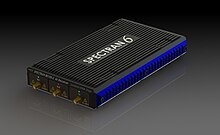Spectrum Analyzer
Table of Contents
What is a spectrum analyzer?
A spectrum analyzer is a device that measures the magnitude of an input signal against the frequency within the full range of the instrument [1]. The main use of this device is to measure the power of the spectrum of known and unknown signals [1]. The most common input signal that is measured is electrical, however other signals can be detected like light waves and pressure waves[1]. By understanding the electrical signals, different components can be observed such as the bandwidth and power [1]. To a casual observer, a spectrum analyzer looks like an oscilloscope, and some lab instruments can function as either a spectrum analyzer or oscilloscope [1].
| Figure 1: Modern and Real-Time Spectrum Analyzer [3] |
Types
Spectrum analyzers are distinguished by the methods that are used to obtain the signal [2]. There are both swept-tuned and fast Fourier transform based spectrum analyzers.
Swept-tuned:
A swept-tuned analyzer uses a super heterodyne receiver to down-convert a portion of the signal to the center frequency of a narrow band-pass filter, whose output power is recorded or displayed as a function of time [2]. By sweeping the receivers center-frequency, the output is also a function of frequency [2]. However, it may miss short-duration events at other frequencies [2].
FFT:
An FFT analyzer computes a time-sequence of periodograms. FFT refers to a particular mathematical algorithm used in the process [2]. It is also commonly used in conjunction with a receiver and analog-to-digital converter [2]. The receiver reduces the center-frequency of a portion of the input signal spectrum, but the portion is not swept [2]. The purpose of this receiver is to reduce the sampling rate that the analyzer must contend with [2]. With a low sample rate, FFT analyzers can process all the samples and are able to avoid missing short duration events [2].
Form Factor
Benchtop:
This spectrum analyzer can be plugged into AC power, which is generally meant for a lab environment [3]. Benchtop spectrum analyzes have historically offered better performance and specifications than the portable or handheld versions [3]. They also normally have multiple fans to dissipate the heat produced by the processor [3]. Due to their architecture, bench top spectrum analyzers typically, weigh more than 30 pounds [3]. Some also offer optional battery packs, which allow them to be used away from AC power [3].
Portable:
This form factor is useful for nay applications where the spectrum analyzer needs to be taken outside to make measurements or simply carried when in use [3]. Portable spectrum analyzers are usually battery powered, clearly viewable in different environments, and is very light at about 15 pounds [3].
Handheld:
This version of the spectrum analyzer is useful for applications where the device has to be very small and light [3]. Handheld analyzers offer limited capabilities compared to its larger versions [3]. They often consume very little power, are battery-powered, and is very small and light [3].
Figure 2: Hand Held Spectrum Analyzer [3] |
|---|
Figure 3: Benchtop Spectrum Analyzer [3] |
|---|
Applications
Spectrum analyzers have multiple applications [4]. This applications include voice and data communications, such as radio communications [4]. They can also be used for video broadcasting using a satellite and digital video [4]. They can also be used for radar transmitter analysis, and interference hunting [4]. One of the most common uses is Wi-fi testing [4].
Figure 4: Spectrum Analyzer Used to Test Wi-Fi Settings [4] |
|---|
|
References
[1] “Spectrum analyzer,” Wikipedia, 30-Mar-2021. [Online]. Available: https://en.wikipedia.org/wiki/Spectrum_analyzer. [Accessed: 06-Apr-2021].
[2] “Different Types of Analyzers,” Different Types of Spectrum Analyzers. [Online]. Available: http://rfmw.em.keysight.com/wireless/helpfiles/89600B/webhelp/subsystems/concepts/Content/concepts_types_spec_an.htm#:~:text=There%20are%20two%20broad%20categories,have%20become%20much%20more%20sophisticated. [Accessed: 06-Apr-2021].
[3] Tektronix, “Spectrum Analyzers & Signal Frequency Analyzers,” Tektronix. [Online]. Available: https://www.tek.com/spectrum-analyzer. [Accessed: 06-Apr-2021].
[4] E. Notes, “Spectrum Analyzer Specifications,” Electronics Notes. [Online]. Available: https://www.electronics-notes.com/articles/test-methods/spectrum-analyzer/spectrum-analyser-specifications-specs.php. [Accessed: 06-Apr-2021].
Contributors:
User Last Update Mayurakhi Khan 1255 days ago
Faculty Advisor: Kim Pope, Allyson Giannikouris, Vincent Gaudet



